SS Choctaw
SS Choctaw was a semi-whaleback freighter built by the Cleveland Shipbuilding Company in 1892. She was a monitor vessel that was designed to evade Alexander McDougall's patent on the whaleback vessel design.[4] She sank on July 11, 1915, on Lake Huron after a collision[5] with the Canadian package freighter Wahcondah.[1] For more than 100 years the location of Choctaw's wreck remained unknown until she was discovered perfectly preserved and on her side on May 23, 2017, in about 300 feet (91 m) of water.[6]
 Choctaw prior to her sinking | |
| History | |
|---|---|
| Name: | Choctaw |
| Operator: |
|
| Port of registry: |
|
| Builder: | Cleveland Shipbuilding Company |
| Yard number: | 17 |
| Launched: | May 15, 1892 |
| In service: | June 24, 1892 |
| Out of service: | July 11, 1915 |
| Identification: | U.S. Registry #126874 |
| Fate: | Rammed by the Canadian steamer Wahcondah on Lake Huron |
| General characteristics | |
| Class and type: | Lake freighter |
| Tonnage: |
|
| Length: | 266 ft (81 m) |
| Beam: | 38 ft (12 m) |
| Depth: | 22.6 ft (6.9 m) |
| Installed power: | 2x Scotch marine boilers |
| Propulsion: | 900 horsepower triple expansion steam engine |
| Crew: | 22 |
CHOCTAW (shipwreck) | |
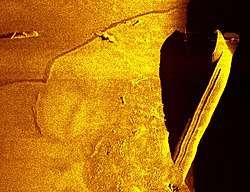 Sonar image of Choctaw | |
  | |
| Location | Lake Huron, approximately five miles east of Presque Isle Light.[1] |
| Coordinates | 45.53401°N 83.5093°W |
| Built | 1892 |
| Built by | Cleveland Shipbuilding Company |
| Architectural style | Shipwreck site |
| NRHP reference No. | 100003214[2][3] |
| Added to NRHP | December 10, 2018 |
History
Design and construction
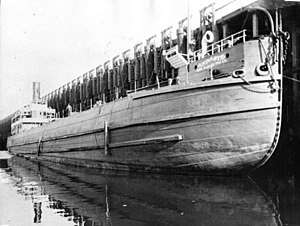

Choctaw was named after the Choctaw Indian tribe from the southern United States.[7] Choctaw was built in 1892 by the Cleveland Shipbuilding Company on the banks of the Cuyahoga River for the Lake Superior Iron Company.[8] She was 266.9 feet (81.4 m) in length with a 38.1-foot (11.6 m) beam[9] and she had a 23-foot-deep (7.0 m) hold and water bottom.[10] She had a cutaway stern, no interior bulkheads between the forward collision bulkhead and the engine bulkhead in her stern, and seven cargo hatches. She could carry 2,800 short tons (2,500 t) when she was fully loaded, at which time she would draw a 16-foot (4.9 m) draft.[11] She was powered by a 900-horsepower triple expansion steam engine and she was fueled by two coal-fired Scotch marine boilers. She also had an identical sister ship named Andaste, and a "near-sister" ship named Yuma.[8][6][12][upper-alpha 1][upper-alpha 2]
Choctaw and Andaste had an unusual design. They were straight-back steel freighters, similar to the iconic whaleback design invented by Captain Alexander McDougall, but unlike whalebacks they had straight sides and a conventional bow. This combination meant that from the waterline upward, their sides sloped inward in a "tumble-home" configuration.[13] They were a hybrid known as "semi-whalebacks".[8]
Service history

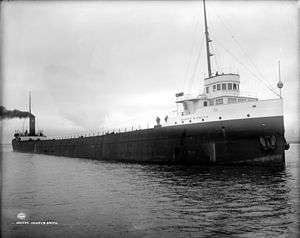
Choctaw was launched May 25, 1892 as hull number #17, and she entered service on June 24, 1892.[4] On April 19, 1893 Choctaw was traveling on Lake St. Clair when she suffered an explosion in her engine room when her cylinder head blew out.[14] Unfortunately the explosion killed two and injured one of her crew.[14][6]
On May 20, 1896 Choctaw collided with the larger steel freighter L.C. Waldo which tore a 10-foot hole in her starboard side, she sank onto a shoal at the Soo Locks in the collision.[14] On June 1, 1896 temporary repairs were made to Choctaw in Sault Ste. Marie, Michigan before she sailed to Cleveland, Ohio.[15][16]
On May 26, 1900, at around midnight Choctaw ran aground near Pointe aux Pins on Lake Erie.[17]
On 26 April 1902 Choctaw struck a rock, or hit the bottom after being lifted by heavy seas, near Marquette, Michigan and partially sank after reaching the shelter of Marquette Harbor.[6][18]
On the day of November 9, Choctaw was in Marquette Harbor during the White Hurricane of 1913 when her Captain, Captain Charles Fox saw the 545-foot (166 m) long steel freighter Henry B. Smith leave the shelter of Marquette Harbor.[19] After about twenty minutes of being battered by waves, Captain James Owen decided to turn Henry B. Smith to port to seek shelter behind the Keweenaw Peninsula. Then all of a sudden Henry B. Smith fell into the trough of a breaking wave and was never seen again; that is until her wreck was located in May 2013 in 535 feet (163 m) of water.[20]
Final voyage and collision
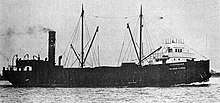
On the day of July 11, 1915 the weather conditions on Lake Huron were very foggy.[21] Choctaw, in command of Captain Charles A. Fox, was upbound from Cleveland, Ohio with a cargo of coal bound for Marquette, Michigan.[3][6] At around 5:30 a.m. Wahcondah (which was downbound with a cargo of wheat from Fort William, Ontario to Montreal, Quebec)[22] sighted Choctaw. Upon sighting her the captain of Wahcondah ordered for the engines of his ship to be reversed. Unfortunately this didn't stop the package freighter from slicing into the port side of Choctaw between her 1st and 2nd cargo hatch. After the collision the captain of Wahcondah lost sight of Choctaw. The crew of Wahcondah relocated Choctaw after sighting her tall smokestack through the heavy fog. Eventually Captain Fox ordered for Choctaw's lifeboats to be lowered, but unfortunately Choctaw sank so quickly that some of her crew couldn't make it to her lifeboats in time and had to jump overboard.[23] Eventually the crew of Choctaw came over to Wahcondah in their own lifeboats.[24] Although Choctaw sank relatively quickly, in only seventeen minutes, her crew of 22 managed to escape.[25][6][26] Wahcondah took the crew of Choctaw to Sarnia, Ontario.[27] The rough location of Choctaw's sinking was given as approximately five miles east of Presque Isle Light.[1]
Choctaw wreck
Searches
Prior to the discovery, there were several unsuccessful attempts to locate Choctaw. Several of them ended with the discovery of one or more wreck.[6][28]
2003 search

In 2003 shipwreck hunter Stan Stock conducted an independent search for Choctaw. Instead of Choctaw, he managed to locate the wreck of the schooner Kyle Spangler.[6]
2008 search
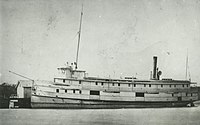
In 2008 shipwreck hunters from the Thunder Bay National Marine Sanctuary collaborated with Stock to map the wreck of Kyle Spangler. In August 2008 they partnered with the University of Rhode Island. Instead of locating Choctaw, they located the wreck of the passenger steamer Messenger.[6]
2011 Search (Project Shiphunt)


For a long time Choctaw was a very sought after shipwreck among shipwreck hunters and divers because of her unique "straight back" design. In 2011 a group consisting of expert shipwreck hunters and high school students tried to locate Choctaw. Their search effort was made into a documentary named "Project Shiphunt". Although they failed to locate Choctaw, they managed to find two other shipwrecks. These were the wrecks of the steel hulled freighter Etruria which sank on the lake after a collision with the larger steel steamer Amasa Stone,[29] and the wreck of the schooner M.F. Merrick which sank in 1889 after a collision with the steamer Rufus P. Ranney.[28]
Discovery
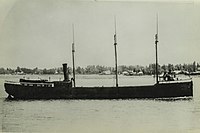
On May 23, 2017 researchers from the Thunder Bay National Marine Sanctuary discovered two shipwrecks deep within the waters of Lake Huron,[30] off the coast of Presque Isle, Michigan.[31][32] The researchers carried out several investigations between June and August; these investigations confirmed the identities of the early wooden hulled freighter Ohio and Choctaw.[33][34][35][36] Ohio was lost on September 26, 1894 when she collided with the schooner Ironton.[32][37][38] Both wrecks are in a place known as "Shipwreck Alley", which is a 448-square-mile area of the Lake Huron shoreline which holds an estimated 200 shipwrecks. The US Federal Government named the area the nation's first National Freshwater Marine Sanctuary in 2000.[33][39][40]
Since the Thunder Bay National Marine Sanctuary did not announce their discovery until September 1, 2017, avocational shipwreck hunters continued to search for Choctaw.[41] On August 13, 2017 independent researcher Dan Fountain found Choctaw using a modified fishfinder. On August 20 he returned to the site with veteran shipwreck hunters Ken Merryman and Jerry Eliason to survey the wreck with Eliason's homemade hi-definition drop video system, positively identifying the wreck as Choctaw.[42]
"These remarkable discoveries remind us that the mystery is still out there—there are still shipwrecks to find, our team is excited to further document Ohio and Choctaw, and tell their stories. We'll keep looking for other wrecks and working to ensure that these treasures are preserved for future generations."
— Jeff Gray, the Thunder Bay National Marine Sanctuary's superintendent.[32]
"Ohio and Choctaw are remarkable examples of two very significant Great Lakes watercraft, and both are beautifully preserved," virtually all of their rigging and deck hardware is intact, and there is clear evidence of the accidents that claimed both vessels. Talk about keeping history alive!"
— Charles Patrick Labadie, a maritime historian.[32]
"These discoveries are a valuable addition to our Great Lakes maritime history, even at their great depth, non-divers and divers alike can learn more about the shipwrecks' stories through sanctuary efforts to document and preserve the sites."
— Steve Kroll, sanctuary Advisory Council member.[32]
Choctaw today
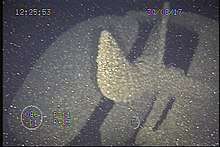
The remains of Choctaw rest in about 300 feet (91 m) of cold fresh water. When the vessel sank, the captain report that "the Choctaw settled by the head soon after the collision, but shortly before she disappeared she rolled to starboard and capsized, going down bottom side up."[3] The wreck lies nearly upside down with its starboard gunwale lowermost.[43] The entire bow, including the area of the collision between the first and the second hatch, is completely buried in the bottom[upper-alpha 3] and is partially covered by the spilled coal cargo. Only the aftermost three of her seven cargo hatches are exposed. Compressive buckling of the port gunwale between the fifth and the sixth hatch and the depression of bottom hull plating nearby suggests that the vessel initially buried its bow in the bottom at a steep angle, then bent "up" and to port amidships as it settled until the after portion came to rest on the bottom, supported by its steel after deckhouse.[6][43]
References
Notes
- Even though Andaste is considered to be Choctaw's only true identical sister ship, there was another ship that looked similar, and fell into the same monitor category as the other two, that ship's name was Yuma. Yuma sailed from her construction in 1893 to her sinking in 1948 as Cohasset in Chesapeake Bay.[12][6]
- After Choctaw sank, her sister ship, Andaste was shortened to a canal size of 246 feet (75 m) in 1920-1921. She continued to sail until disappearing with all hands on Lake Michigan. Her wreck has not yet been located.[8]
- Despite the fact that only the first two of her hatches are buried, the NOAA website states that Choctaw is half buried in the lake bottom.[6]
Citations
- "SS Choctaw (+1915)". Wrecksite. Retrieved March 24, 2018.
- "National Resister of Historic Places: Weekly List 20181210". National Park Service. December 14, 2018. Retrieved December 19, 2018.
- "CHOCTAW Shipwreck Site National Register of Historic Places Registration Form" (PDF). Michigan.gov. Archived from the original (PDF) on January 1, 2019. Retrieved December 31, 2018.
- "Choctaw". Great Lakes Vessel Histories of Sterling Berry. Retrieved March 4, 2018.
- "When the steel steamer CHOCTAW sank on a foggy July day in 1915, it sounded like "a million dishes and hundreds of sticks were being broken as the ship rolled over."". Facebook-NOAA Thunder Bay National Marine Sanctuary.
- "Two Historic Shipwrecks Discovered in Thunder Bay National Marine Sanctuary". Thunder Bay National Marine Sanctuary. Archived from the original on December 21, 2018. Retrieved March 4, 2018.
- Greenwood, John Orville (1998). The Fleets of Cleveland-Cliffs, Detroit and Cleveland Navigation, Traverse City Transportation and the Hawgood family. Freshwater Press. p. 34. ISBN 978-0-912514-57-4.
The CHOCTAW was named for the Choctaw Indian tribe of the southern United States.
CS1 maint: ref=harv (link) - "Andaste". Michigan Shipwrecks. Retrieved March 4, 2018.
- Devendorf, John F. (1996). Great Lakes Bulk Carriers, 1869–1985. Niles, Michigan: J.F. Devendorf. p. 80. ISBN 9781889043036.CS1 maint: ref=harv (link)
- "Choctaw". Bowling Green State University. Retrieved March 4, 2018.
- "Lake Marine News". The Plain Dealer. Cleveland. April 1, 1892. p. 4.
- "Cleveland Shipbuilding, Cleveland and Lorain OH". Shipbuilding History. Archived from the original on September 3, 2017. Retrieved March 24, 2018.CS1 maint: BOT: original-url status unknown (link)
- Boyer, Dwight (1968). Ghost Ships of the Great Lakes. New York: Dodd, Mead and Company. pp. 59–79. ISBN 0912514477.
- "Choctaw; 1892; Bulk Freighter; US126874". Great Lakes Maritime Database. Retrieved March 25, 2018.
- "Choctaw (Propeller), U126874, 20 May 1896". Maritime History of the Great Lakes. Retrieved March 23, 2018.
- "L.C. Waldo (Propeller), U141421, collision, 20 May 1896". Maritime History of the Great Lakes.
- "Choctaw (Propeller), U126874, aground, 26 May 1900". Maritime History of the Great Lakes. Retrieved March 23, 2018.
- "Annual report of the Supervising Inspector-general Steamboat-inspection Service, Year ending June 30, 1903". Washington: Government Printing Office. 1903. p. 67. Retrieved May 7, 2020 – via Haithi Trust.
- Thompson, Mark L. (April 13, 2004). Graveyard of the Lakes. Great Lakes Books Series. Detroit: Wayne State University Press. p. 353. ISBN 9780814332269.
- Krueger, Andrew (July 1, 2013). "Video confirms wreck is freighter Henry B. Smith: New video taken more than 500 feet beneath the surface of Lake Superior confirms that a shipwreck discovered earlier this year is indeed the long-lost freighter Henry B. Smith". Duluth News Tribune.
- "Northern Michigan in Focus: Shipwreck Discoveries". 9&10 News. Retrieved December 21, 2018.
- "Ship of the Month No. 96 Wahcondah". Maritime History of the Great Lakes. Retrieved March 5, 2018.
- "Saves Wrecked Crew-Choctaw Goes Down Before Men Can Launch Lifeboats". South Bend News-Times. Retrieved May 1, 2018.
- "Wreck report for the Choctaw and the Wahcondah, 1915" (PDF). Portcities Southampton. Retrieved March 5, 2018.
- "Two Shipwrecks Discovered in Thunder Bay National Marine Sanctuary". Scuba Diver Life. Retrieved January 12, 2019.
- "Choctaw (1892, Bulk Freighter)". Alpena County George N. Fletcher Public Library-Great Lakes Maritime Collection. Retrieved April 28, 2018.
- "Steamer Sinks After Collision, Crew Reaches Port". The Bridgeport Evening Farmer. Retrieved May 1, 2018.
- "Project Shipment". Thunder Bay National Marine Sanctuary. Retrieved March 11, 2018.
- "Etruria". Thunder Bay National Marine Sanctuary. Retrieved May 11, 2018.
- "Two historic Great Lakes shipwrecks discovered in Thunder Bay National Marine Sanctuary". Friends of Thunder Bay National Marine Sanctuary. Retrieved January 12, 2019.
- "Two century-old shipwrecks discovered in Lake Huron". The Detroit News. Retrieved March 23, 2018.
- "Finding History: The discovery of two lost shipwrecks in Thunder Bay National Marine Sanctuary". Thunder Bay National Marine Sanctuary. Retrieved March 23, 2018.
- "Found: Two Shipwrecks Deep in a Shipwreck Graveyard". Atlas Obscura. Retrieved March 25, 2018.
- "Researchers discover 2 century-old shipwrecks in Lake Huron". Shipwreck Explorers. Retrieved March 25, 2018.
- "2017 Awards Program". Association for Great Lakes Maritime History. Retrieved March 25, 2018.
- "Two century-old shipwrecks found in Lake Huron off Michigan coast". Los Angeles Times. Retrieved May 1, 2018.
- "US Researchers Discover Two Century-Old Shipwrecks in Lake Huron". VOA News. Retrieved May 1, 2018.
- "Two century-old steamer shipwrecks discovered in Lake Huron". Grand Rapids News. Retrieved May 1, 2018.
- "Two century-old shipwrecks found in Lake Huron". The Toronto Sun. Retrieved March 25, 2018.
- "In Lake Huron, Underwater Treasures And A Marine Sanctuary Boost Tourism Industry". National Public Radio. Retrieved May 1, 2018.
- "Ships that go Bump in the Night: Collisions off Presque Isle by Dan Fountain". Marquette 265. Retrieved January 13, 2019.
- "Sunken Treasure". The Mining Journal. Retrieved January 13, 2019.
- "CHOCTAW Shipwreck in Lake Huron". Michigan Gold-YouTube. Retrieved January 22, 2019.
Further reading
- Great Lakes Register (1916). Great Lakes Register for the Construction and Classification of Steel and Wooden Vessels. Vol. 18. Cleveland: Great Lakes Register. hdl:2027/mdp.39015057176235.
- Lloyd's Register of British and Foreign Shipping (1902). Lloyd's Register of British and Foreign Shipping.
- Ratigan, William (1977). Great Lakes Shipwrecks & Survivals. Grand Rapids, Michigan: Wm. B. Eerdmans Publishing. ISBN 0-8028-7010-4.
- Wright, Richard J. (1969). Freshwater Whales: A History of the American Ship Building Company and Its Predecessors. Kent, Ohio: Kent State University Press. ISBN 9780873380539.CS1 maint: ref=harv (link)
See also
Images
| Wikimedia Commons has media related to SS Choctaw. |
 Painting of Choctaw by Howard Freeman Sprague (1871-1899)
Painting of Choctaw by Howard Freeman Sprague (1871-1899) A photograph of Choctaw sailing into an unknown port
A photograph of Choctaw sailing into an unknown port A photograph of Choctaw sailing light
A photograph of Choctaw sailing light An early photograph of Choctaw
An early photograph of Choctaw A photograph of Choctaw sailing fully loaded
A photograph of Choctaw sailing fully loaded A photograph of Choctaw at a dock
A photograph of Choctaw at a dock